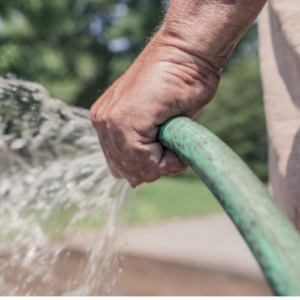It’s easy to forget how much we use our hands with force in the garden. Quite often, it is not just the force itself that presents a challenge but the fact that the objects we are gripping are not ideally shaped or sized. Bags of potting mix, mulch and fertiliser have a load that shifts around and there a no handles to help hold them. Pruning tools can often require force in an extended gripping position.
With this in mind, let’s cover some of the simple strategies that you can use to make sure you prepare your muscles for all these different demands. Let’s start with the easy and obvious option of building up strength with specific grip strengthening exercises. There are a couple of elements that you want to make sure to include with these. Firstly, we need to build the strength to carry load with varying grip widths. Most objects try to make carrying easier and create a handle that is best suited to the strongest position of the wrist. Take for example a dumbbell hand weight. The handle of the weight is designed specifically with this in mind. This can be changed by wrapping a hand towel around the handle a few times to try and increase the size and stretch the muscles and joints to increase their challenge.
We also want to prepare the wrist for different typed of grip. We don’t always have the luxury of holding a load in the palm of the hand with the fingers and thumb wrapped around. Training a pinch grip is also important and can easily be done by holding a book in between your fingers and thumbs while moving the wrist and arm. As mentioned above, try this with objects of varying width to ensure that your pinch grip is strengthened in multiple different positions.
Another way to challenge the gripping demands is to hold onto an object in a position where the load is not balanced. If we look at the design of the hand weight, again we notice that the handle is positioned perfectly in the middle of the symmetrical loads to make it easier for the wrist muscles to keep the load under control. In contrast, if we hold the narrow top of a bottle, the load is offset to the opposite end which will provide an extra challenge for the wrist muscles as we lift and move the bottle around.
A final consideration when looking at hand and wrist strength is to strengthen the opposite muscles to those used in grip. The elastic bands that are used to keep bunches of broccolini and asparagus together are perfect for this. You can wrap the elastic band around the fingers and thumb and focus on stretching the fingers and thumbs apart as wide as you can, as well as focusing on the thumb individually in different directions. This helps to maintain the balance of the muscles and stretches the muscles and tissues that are used in gripping.
When you are out in the garden using any of the tools or lifting items, it is important to look at your wrist position and where possible keep it in what we would refer to as a neutral position. To find a neutral wrist position, we want to make sure that the wrist is not bent forward or backward, and that it is not tilted to the thumb or little finger side. In this position, the muscles are in an ideal position to develop their maximum force. If we move too far from this position, we put the muscles in a shorter or longer position making it more challenging for them to generate force. We can also change the focus of the loads to certain muscles which can be strained over time. Of course there will be situations where you are unable to avoid awkward positions, however we want to try and make sure that in these situations we take regular breaks and use the wrist in a different position so that we don’t build up too much load.
A final consideration when it comes to grip is the use of power tools. Many of the gardening tools are powered by a battery or motor to make gardening tasks easier or more efficient. The only downside to this is the vibration that accompanies such tools. This increases the demands on the arm and hand muscles as they have to work harder to control the position of the tool. The best way to try and avoid overloading these muscles when using power tools is to ensure that your wrist is in a strong and neutral position, and also again to take regular breaks from the tool and change up the demands on the area with different tasks.

